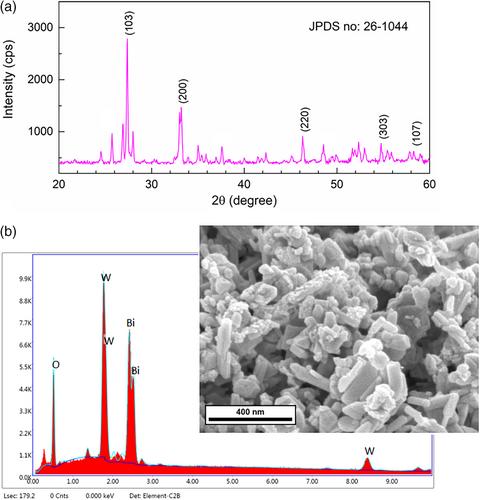下载PDF
{"title":"The evaluation of the effect of metal oxide and ferroelectric ceramic additives on the structural and dielectric properties of epoxy matrix","authors":"Nazlıcan Şahin, Yaşar Karabul, Mehmet Kılıç, Zeynep Güven Özdemir, Kadir Esmer","doi":"10.1002/pi.6564","DOIUrl":null,"url":null,"abstract":"<p>This study focused on examining and comparing the effects of Bi<sub>2</sub>O<sub>3</sub>, WO<sub>3</sub>, and ferroelectric Bi<sub>2</sub>WO<sub>6</sub> ceramic particles on the frequency-dependent electrical properties of an epoxy matrix, which is known for its good mechanical strength, easy processability, high oxidation resistance, low dielectric loss, and sealing and adhesive properties. The reinforcing particles as well as the composites were examined by Fourier transform infrared analysis, and electrical measurements were carried out at room temperature with an impedance analyzer in the range 20 Hz to 1 MHz. The energy storage performances of the three composite families were compared by limiting the analysis to the real and imaginary components of the complex dielectric constant (<i>ε</i>′ and <i>ε</i>″), the AC conductivity, and the phase angle. When the <i>ε</i>′ and <i>ε</i>″ values of the pure epoxy and the 20% by mass Bi<sub>2</sub>O<sub>3</sub>, WO<sub>3</sub> and Bi<sub>2</sub>WO<sub>6</sub> doped composites were compared it was observed that WO<sub>3</sub> additive causes higher <i>ε</i>′ values than the other additives in the entire frequency region, ignoring the high dielectric loss. However, when <i>ε</i>′ and <i>ε</i>″ were evaluated together, Bi<sub>2</sub>O<sub>3</sub> and Bi<sub>2</sub>WO<sub>6</sub> additives caused lower dielectric loss than WO<sub>3</sub> and higher <i>ε</i>′ values than pure epoxy which make these additives more advantageous than WO<sub>3</sub> for energy storage applications. In addition to these examinations, frequency-dependent phase angle evaluation has suggested that 30% Bi<sub>2</sub>O<sub>3</sub> and 20% Bi<sub>2</sub>WO<sub>6</sub> additives can be considered promising for energy storage applications in the high-frequency region. © 2023 The Authors. <i>Polymer International</i> published by John Wiley & Sons Ltd on behalf of Society of Industrial Chemistry.</p>","PeriodicalId":20404,"journal":{"name":"Polymer International","volume":"73 1","pages":"9-20"},"PeriodicalIF":2.9000,"publicationDate":"2023-07-19","publicationTypes":"Journal Article","fieldsOfStudy":null,"isOpenAccess":false,"openAccessPdf":"https://onlinelibrary.wiley.com/doi/epdf/10.1002/pi.6564","citationCount":"0","resultStr":null,"platform":"Semanticscholar","paperid":null,"PeriodicalName":"Polymer International","FirstCategoryId":"92","ListUrlMain":"https://onlinelibrary.wiley.com/doi/10.1002/pi.6564","RegionNum":4,"RegionCategory":"化学","ArticlePicture":[],"TitleCN":null,"AbstractTextCN":null,"PMCID":null,"EPubDate":"","PubModel":"","JCR":"Q2","JCRName":"POLYMER SCIENCE","Score":null,"Total":0}
引用次数: 0
引用
批量引用
Abstract
This study focused on examining and comparing the effects of Bi2 O3 , WO3 , and ferroelectric Bi2 WO6 ceramic particles on the frequency-dependent electrical properties of an epoxy matrix, which is known for its good mechanical strength, easy processability, high oxidation resistance, low dielectric loss, and sealing and adhesive properties. The reinforcing particles as well as the composites were examined by Fourier transform infrared analysis, and electrical measurements were carried out at room temperature with an impedance analyzer in the range 20 Hz to 1 MHz. The energy storage performances of the three composite families were compared by limiting the analysis to the real and imaginary components of the complex dielectric constant (ε ′ and ε ″), the AC conductivity, and the phase angle. When the ε ′ and ε ″ values of the pure epoxy and the 20% by mass Bi2 O3 , WO3 and Bi2 WO6 doped composites were compared it was observed that WO3 additive causes higher ε ′ values than the other additives in the entire frequency region, ignoring the high dielectric loss. However, when ε ′ and ε ″ were evaluated together, Bi2 O3 and Bi2 WO6 additives caused lower dielectric loss than WO3 and higher ε ′ values than pure epoxy which make these additives more advantageous than WO3 for energy storage applications. In addition to these examinations, frequency-dependent phase angle evaluation has suggested that 30% Bi2 O3 and 20% Bi2 WO6 additives can be considered promising for energy storage applications in the high-frequency region. © 2023 The Authors. Polymer International published by John Wiley & Sons Ltd on behalf of Society of Industrial Chemistry.
金属氧化物和铁电陶瓷添加剂对环氧树脂基体结构和介电性能影响的评价
环氧树脂基体以其良好的机械强度、易加工性、高抗氧化性、低介电损耗、密封性和粘合性而著称,本研究的重点是研究和比较 Bi2O3、WO3 和铁电 Bi2WO6 陶瓷颗粒对环氧树脂基体随频率变化的电性能的影响。通过傅立叶变换红外分析对增强粒子和复合材料进行了检测,并在室温下使用阻抗分析仪在 20 Hz 至 1 MHz 范围内进行了电学测量。通过限制分析复介电常数的实部和虚部(ε′和ε″)、交流电导率和相位角,比较了三种复合材料的储能性能。当比较纯环氧树脂和质量分数为 20% 的 Bi2O3、WO3 和 Bi2WO6 掺杂复合材料的 ε′ 和 ε″ 值时发现,WO3 添加剂在整个频率区域都比其他添加剂产生更高的ε′值,忽略了高介电损耗。然而,当同时评估ε′和ε″时,Bi2O3 和 Bi2WO6 添加剂造成的介电损耗比 WO3 低,ε′值比纯环氧树脂高,这使得这些添加剂在储能应用中比 WO3 更具优势。除了这些研究之外,与频率相关的相位角评估表明,30% 的 Bi2O3 和 20% 的 Bi2WO6 添加剂在高频区域的储能应用中大有可为。© 2023 作者。国际聚合物》由 John Wiley & Sons Ltd 代表工业化学学会出版。
本文章由计算机程序翻译,如有差异,请以英文原文为准。


 求助内容:
求助内容: 应助结果提醒方式:
应助结果提醒方式:


